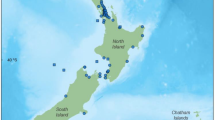Abstract
Short-term changes in testicular spermatozoa, testes weight, testes length, epididymes weight, epididymal spermatozoa, and body weight of adult and yearling male white-tailed deerOdocoileus virginianus (Zimmermann, 1780) were examined over a 9-week period that included the peak of the breeding season in South Carolina. Mean values for all characteristics were significantly greater in adults compared to yearlings. Values for reproductive characteristics tended to be highest during the last week in October or the first week in November and decreased over the course of the investigation. Body weight of adults decreased from late October through early December, whereas body weight of yearlings fluctuated only slightly throughout the 9-week period. Significant correlations were observed among all reproductive characteristics and body weight was highly correlated with all characteristics except testicular spermatozoa. Values for reproductive characteristics differed significantly between the right and left sides of the reproductive tracts. Results demonstrate the occurrence of short-term changes in reproductive capabilities of white-tailed deer that are relevant for the development of management strategies for this species.
Similar content being viewed by others
References
Amann R. P. and Almquist J. O. 1961. Reproductive capacity of dairy bulls. I. Technique for direct measurement of gonadal and extra-gonadal sperm reserves. Journal of Dairy Science 44: 1537–1543.
Asher G. W., Berg D. K., Beaumont S., Morrow C. J., O’Neill K. T. and Fisher F. W. 1996. Comparison of seasonal changes in reproductive parameters of adult male European fallow deer (Dama dama dama) and hybrid Mesopotamian × European fallow deer (D. d. Mesopotamian ×D. d. dama). Animal Reproduction Science 45: 201–215.
Blottner S., Hingst O. and Meyer H. H. D. 1996. Seasonal spermatogenesis and testosterone production in roe deer (Capreolus capreolus). Journal of Reproduction and Fertility 108: 299–305.
Bubenik G. A., Bubenik A. B., Schams D. and Leatherland J. F. 1983. Circadian and circannual rhythms of LH, FSH, testosterone, prolactin, cortisol, T3, and T4 in plasma of mature, male white-tailed deer. Comparative Biochemistry and Physiology 76: 37–45.
Gosch B. and Fischer K. 1989. Seasonal changes of testis volume and sperm quality in adult fallow deer (Dama dama) and their relationship to the antler cycle. Journal of Reproduction and Fertility 85: 7–18.
Gruver B. J., Guynn D. C. Jr and Jacobson H. A. 1984. Simulated effects of harvest strategy on reproduction in white-tailed deer. The Journal of Wildlife Management 48: 535–541.
Lambiase J. T. Jr, Amann R. P. and Lindzey J. S. 1972. Aspects of reproductive physiology of male white-tailed deer. The Journal of Wildlife Management 36: 868–875.
Lincoln G. A. 1985. Seasonal breeding in deer. [In: Biology of deer production. P. F. Fennessy and K. R. Dews, eds]. Royal Society of New Zealand, Wellington, New Zealand: 165–180.
McMillin J. M., Seal U. S., Keenlyne K. D., Erichson A. W. and Jones J. E. 1974. Annual testosterone rhythms in the adult white-tailed deer (Odocoileus virginianus borealis). Endocrinology 94: 1034–1040.
Miller K. V., Rhodes O. E. Jr, Litchfeld T. R., Smith M. H. and Marchinton R. L. 1987. Reproductive characteristics of yearling and adult male white-tailed deer. Proceedings of the Annual Conference of the Southeastern Association of Fish and Wildlife Agencies 41: 378–384.
Miller S. K. 1989. Reproductive biology of white-tailed deer on Cumberland Island, Georgia. U. S. National Park Service Cooperative Unit Technical Report No. 52. University of Georgia, Athens, Georgia: 1–97.
Mirarchi R. E., Scanlon P. F. and Kirkpatrick R. L. 1977a. Annual changes in spermatozoan production and associated organs of white-tailed deer. The Journal of Wildlife Management 41: 92–99.
Mirarchi R. E., Scanlon P. F., Kirkpatrick R. L. and Schreck C. B. 1977b. Androgen levels and antler development in captive and wild white-tailed deer. The Journal of Wildlife Management 41: 178–183.
Mirarchi R. E., Howland B. E., Scanlon P. F., Kirkpatrick R. L. and Sanford L. M. 1978. Seasonal variation in plasma LH, FSH, prolactin and testosterone concentrations in adult male white-tailed deer. Canadian Journal of Zoology 56: 121–127.
Peles J. D., Rhodes O. E. Jr and Smith M. H. 2000. Spermatozoan numbers and testicular characteristics of male white-tailed deer fawns during the breeding season. Acta Theriologica 45: 95–102.
Rhodes O. E. Jr, Novak J. M., Smith M. H. and Johns P. E. 1991. Frequency distribution of conception dates in a white-tailed deer herd. Acta Theriologica 36: 131–140.
Severinghaus C. W. 1949. Tooth development and wear as criteria of age in white-tailed deer. The Journal of Wildlife Management 13: 195–216.
Scanlon P. F. and Lenker D. K. 1983. Male reproductive characteristics of white-tailed deer during November and December. Theriogenology 19: 855–867.
Smith M. H., Chesser R. K., Cothran E. G. and Johns P. E. 1982. Genetic variability and antler growth in a natural population of white-tailed deer. [In: Antler development in Cervidae. R. D. Brown, ed]. Kleberg Wildlife Research Institute, Kingsville, Texas: 365–387.
Wooten M. C. and Smith M. H. 1986. Fluctuating asymmetry and genetic variability in a natural population of Mus musculus. Journal of Mammalogy 67: 725–732.
Author information
Authors and Affiliations
Rights and permissions
About this article
Cite this article
Peles, J.D., Rhodes, O.E. & Smith, M.H. Spermatozoan numbers and characteristics of associated organs in male white-tailed deer during the breeding season. Acta Theriol 48, 123–130 (2003). https://doi.org/10.1007/BF03194272
Received:
Accepted:
Issue Date:
DOI: https://doi.org/10.1007/BF03194272




